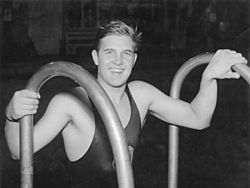Adolph Kiefer facts for kids

Kiefer in Vienna in 1935
|
|||||||||||
| Personal information | |||||||||||
|---|---|---|---|---|---|---|---|---|---|---|---|
| Nickname(s) | "Sonny Boy" "Old Man Kiefer" | ||||||||||
| Born | June 27, 1918 Chicago, Illinois, U.S. |
||||||||||
| Died | May 5, 2017 (aged 98) Wadsworth, Illinois, U.S. |
||||||||||
| Sport | |||||||||||
| Sport | Swimming | ||||||||||
| Strokes | Backstroke | ||||||||||
| Club | Lake Shore Athletic Club | ||||||||||
| College team | University of Texas | ||||||||||
|
Medal record
|
|||||||||||
Adolph Gustav Kiefer (born June 27, 1918 – died May 5, 2017) was an amazing American swimmer. He won a gold medal at the 1936 Summer Olympics. He was also the last living gold medalist from those games. Adolph Kiefer was the first person ever to swim the 100-yard backstroke in less than one minute. He also invented new swimming products and helped many people learn to swim.
Contents
Early Life and School
Adolph Kiefer was born in Chicago, Illinois. His parents had moved there from Germany. He went to Roosevelt High School. Later, he studied at the University of Texas at Austin and Columbia University.
Breaking Records Early On
Adolph Kiefer was only 16 years old when he made history. In 1935, he became the first person to swim the 100-yard backstroke in under a minute. His time was 59.8 seconds. The next year, he swam it even faster, in 58.5 seconds. This was an Illinois state high school record for a long time. In 1940, he set another world record, swimming the 100-yard backstroke in 57.9 seconds. Overall, he broke 23 records after his first sub-minute swim. He also set a world record for the 100-meter backstroke in 1936.
Winning Gold at the Berlin Olympics
When he was 18, Adolph Kiefer went to the 1936 Summer Olympics in Berlin, Germany. On August 14, he won the gold medal in the men's 100-meter backstroke. He set new Olympic records three times during the competition. His final Olympic record time was 1 minute and 5.9 seconds. This record stood for over 20 years!
After the Olympics
After the Olympics, Adolph Kiefer became a national hero. He traveled around the world with other U.S. Olympic medalists. He challenged other great swimmers in different countries.
Adolph Kiefer was an incredible swimmer. He only lost two races out of more than 2,000! One of those losses was in 1943 to Harry Holiday, Jr.. Holiday beat him in the 150-yard backstroke. Soon after, Kiefer joined the U.S. Navy.
Kiefer joined the U.S. Navy in 1943. He started as a Chief Petty Officer. The Navy realized that many sailors were drowning. So, Kiefer was asked to help create new safety and training rules. He quickly became the Officer in Charge of Swimming for the entire U.S. Navy. He trained over 13,000 Navy swim instructors.
Kiefer taught them a special stroke he called the "Victory backstroke." This was a simpler way to swim on your back. It helped new swimmers breathe easily. It also used a more floating style. The American Red Cross later added this stroke to their training. By the end of the war, he was a Lieutenant.
Business and Community Work
In 1947, Adolph Kiefer started his own company, Adolph Kiefer & Associates, Inc. His company made swimming equipment for training, safety, and competitions. His brother, Edward Kiefer, helped create the first nylon swimsuit in 1948. This was a big improvement over the old wool and cotton suits. The U.S. Olympic Swim Team used these new nylon suits.
Adolph Kiefer loved seahorses after seeing them while scuba diving. He even used seahorse pictures in his company's logo!
He also spent a lot of time helping his community. In the 1960s, he worked with Mayor Richard J. Daley to build swimming pools in Chicago. This helped thousands of children learn to swim. Kiefer also supported Swim Across America. This group raises money for cancer research. He even swam in their events when he was in his 70s and 80s!
Later Years
In 1965, Adolph Kiefer was honored as an "Honor Swimmer." He was part of the first group of people to join the International Swimming Hall of Fame. In 1966, he invented and patented a special design for racing lanes. These lanes helped stop waves and made races fairer.
Kiefer celebrated his 90th and 94th birthdays at the U.S. Olympic Swimming Trials. He even awarded medals for the 200-meter backstroke. In 2013, USA Swimming called him the "father of American swimming." This was to honor all his amazing work.
Adolph Kiefer passed away at his home in Wadsworth, Illinois, on May 5, 2017. He was 98 years old.
Family
Adolph Kiefer married Joyce Kainer in 1941. They had four children: two sons, Dale and Jack, and two daughters, Kathy and Gail.
See Also
 In Spanish: Adolf Kiefer para niños
In Spanish: Adolf Kiefer para niños
- List of members of the International Swimming Hall of Fame
- List of Olympic medalists in swimming (men)
- List of University of Texas at Austin alumni

